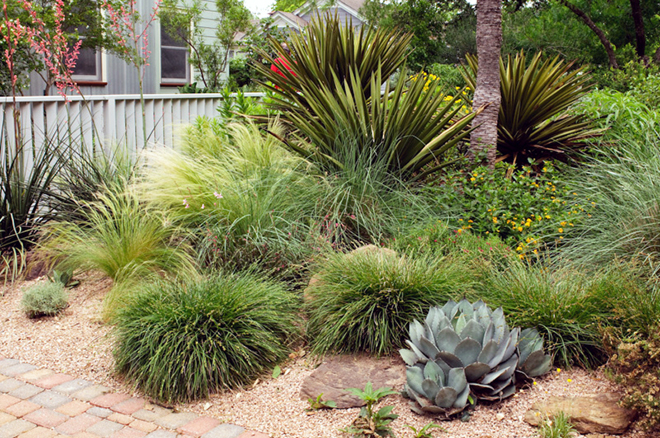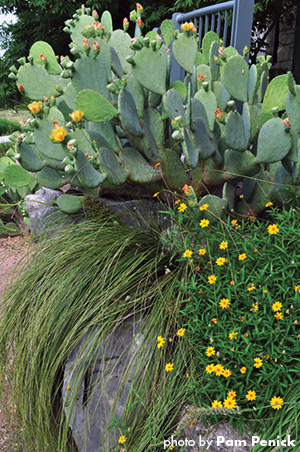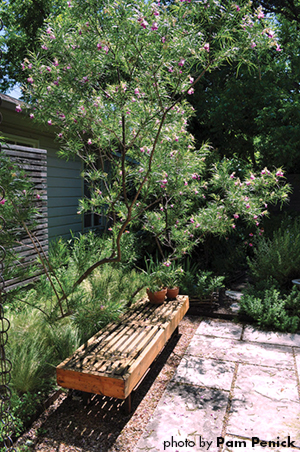Growing Dry

Dry gardens can be lush gardens, too. This wildlife-certified garden in Austin, Texas uses natives like red yucca (Hesperaloe parviflora), Mexican feather grass (Nassella tenuissima) and Gaura sp. to create a soft vibe.
IF GRAVEL ACCENTED WITH A FEW LONELY CACTI and a cow skull is all that comes to mind when you think of a dry garden, it’s time to update this dusty Old West vision. Drought across the western U.S. and widespread interest in gardening more sustainably, with less water, are inspiring a renewed appreciation of dry gardens. These are, quite simply, gardens that thrive on rainfall alone or an occasional deep watering but can do without regular irrigation. Dry gardens can be surprisingly lush, layered with plants adapted to sparse rainfall, tolerant of periods of drought, and stoic in harsh conditions that make thirstier plants shrivel their toes and droop in protest.
“Your garden should not die when the power or water is shut off,” says Phoenix landscape architect Steve Martino. Using dry-adapted native plants is key to creating a garden that isn’t tethered to the hose, but you can’t just plant them and walk away. Even tough natives need some TLC when they’re getting established. To ensure their success, follow these guidelines when making your dry garden.

Contrasting forms break up the masses of fine texture dry gardens are prone to, as in this combo of spineless prickly pear (Opuntia ellisana), zexmenia (Wedelia acapulcensis var. hispida) and Texas sacahuista (Nolina texana).
Match plants to place
Being “native” does not necessarily make a plant suitable for a dry garden; seek out natives from your region that require good drainage or grow naturally on dry, rocky slopes, and that prefer the same sun or shade conditions as your garden offers. If your yard is consistently moist, forget about making a dry garden except in containers. Plant needs must match the site. Minor soil amendments can be useful, however. If your soil contains a lot of clay, add compost and decomposed granite to loosen soil and give your plants better drainage.
Plant on berms or in basins
Dry-loving plants can be susceptible to rot during periods of heavy rain if they lack sharp drainage such as they’d enjoy on a slope or in rocky soil. To keep their crowns dry, try planting on berms built up with gravelly soil. Shape a berm so that it curves in a gentle arc, and merge it with the larger garden in order to avoid the “burial mound” look of a berm plopped in the middle of a lawn. In drier climates, where rot is seldom a concern but thirst is, harness rainwater by planting in broad, shallow basins. Such basins collect rainwater, preventing it from simply running off the surface and allowing it to soak deeply into the soil, nourishing plants’ roots.
Know when to plant
Plant shrubs and trees in autumn rather than in spring. They can grow their roots all fall and winter (in mild climates) without the stress of summer heat and drought. By the time warmer weather does roll around, they’ll be primed to put on new top growth.
Most native perennials can be planted in fall too. Some, however, like blackfoot daisy (Melampodium leucanthum), dislike winter moisture and may rot if they aren’t well-established. Plant these in spring. Of course, climate varies considerably across the country, so follow appropriate planting instructions for your region and your particular plants.

Trees don’t have to be huge to provide water-conserving shade for smaller plants. Although airy, desert willow (Chilopsis linearis) casts a bit of light shade, plus it flowers beautifully.
Water regularly to establish
A common mistake in dry gardening is thinking you can plant it and forget it. But even the most xeric – i.e., dry-loving – plant needs regular water to get established. Horticulturist Julie Marcus agrees. “I’ve heard people say [after losing a plant], ‘I thought that was supposed to be one of those zero plants.’ But it has to be established before it can be xeric.” She advises watering trees and shrubs regularly for the first two years after planting; perennials for one year. Over time, lessen the frequency of irrigation, giving an occasional deep soaking only during unusually hot, dry periods. In dry-summer, wet-winter Mediterranean climates like the West Coast, established natives prefer to receive moisture during winter, not summer.
Finish with mulch
Bare soil dries out quickly, stressing plants. Give your dry garden a leg up by mulching to preserve soil moisture. An inch of mineral mulch or one to two inches of wood mulch keeps soil cooler and roots moist. Mineral mulches like decomposed granite and pea gravel look best in sunny gardens that don’t get a lot of leaf litter, and they helpfully drain moisture away from the rot-prone crowns of certain plants. However, gravel is a perfect nursery for weed seeds, so regular weeding is essential. For dry shade gardens, pecan shell mulch looks natural and suppresses weeds too.
Pam Penick is the author of “Lawn Gone!” and “The Water-Saving Garden.” Learn more about Pam here.

